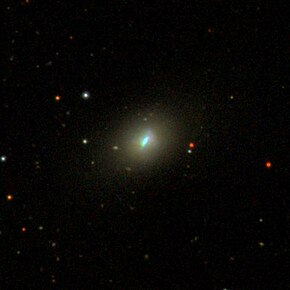Haro 2
| Haro 2 | |
|---|---|
 Haro 2 bySloan Digital Sky Survey | |
| Observation data (J2000epoch) | |
| Constellation | Ursa Major |
| Right ascension | 10h32m32.0s[1] |
| Declination | 54° 24′ 02″[1] |
| Redshift | 0.004796 ± 0.000007[1] |
| Heliocentric radial velocity | 1438 ± 2km/s[1] |
| Distance | 124± 58Mly(38 ± 18Mpc)[1] |
| Apparent magnitude(V) | 13.1 |
| Characteristics | |
| Type | Im pec[1] |
| Apparent size(V) | 1.12′× 0.80′[1] |
| Notable features | Blue compact dwarf |
| Other designations | |
| UGC5720,Arp233,MRK33,MCG+09-17-070,PGC31141[1] | |
Haro 2is ablue compact galaxyin the constellationUrsa Major.The galaxy lies about 120 millionlight yearsaway from Earth based on redshift independent measurements, which means, given its apparent dimensions, that Haro 2 is approximately 45,000 light years across, while redshift indicates a distance of 70 million light years.[1]
Guillermo Harofirst described H2 in a study published in 1956 listing 44 galaxies that were blue.[2]Blue compact galaxies have been found to host large numbers of young massive stars due to aburst of star formation.The galaxy spectrum features emission fromWolf-Rayet stars.[3]The age of the current starburst activity is calculated to be 5.8 ± 1.0 million years.[4]
An outflow of ionised gas around the centralHII regionforming a shell could begalactic windcreated by the starburst activity in the centre of the galaxy. The galaxy has been found to emitLyman- Alphaboth from the central HII region and the shell.[5]The expanding shell has also been observed in X-rays withROSAT,indicating it forms asuperbubble.[4]Imaging of CO(2–1) indicates that the shell has entrained molecular gas.[6]The kinematics of the shell suggest that it has an age of 5 to 6 million years.[7]
See also
[edit]- NGC 3353- a similar dwarf galaxy
References
[edit]- ^abcdefghi"NASA/IPAC Extragalactic Database".Results for UGC 5720.Retrieved2024-03-26.
- ^G. Haro (1956)."Preliminary note on blue galaxies with nuclear emission".Astronomical Journal.1:178.Bibcode:1956AJ.....61R.178H.doi:10.1086/107409.
- ^Kunth, D.; Joubert, M. (1 January 1985)."Wolf-Rayet stars in" lazy "galaxies: a statistical approach".Astronomy and Astrophysics.142:411–420.Bibcode:1985A&A...142..411K.ISSN0004-6361.
- ^abSummers, L. K.; Stevens, I. R.; Strickland, D. K. (21 October 2001)."The energetics and mass loss of the dwarf starburst Markarian 33".Monthly Notices of the Royal Astronomical Society.327(2): 385–396.arXiv:astro-ph/0106475.Bibcode:2001MNRAS.327..385S.doi:10.1046/j.1365-8711.2001.04722.x.
- ^Lequeux, J.; Kunth, D.; Mas-Hesse, J. M.; Sargent, W. L. W. (1 September 1995)."Galactic wind and Lyman α emission in the blue compact galaxy Haro 2 = MKN 33".Astronomy and Astrophysics.301:18.Bibcode:1995A&A...301...18L.ISSN0004-6361.
- ^Beck, Sara C; Hsieh, Pei-Ying; Turner, Jean (1 May 2020)."SMA observations of Haro 2: molecular gas around a hot superbubble".Monthly Notices of the Royal Astronomical Society.494(1): 1–9.arXiv:1909.04971.doi:10.1093/mnras/staa660.
- ^Legrand, F.; Kunth, D.; Mas-Hesse, J. M.; Lequeux, J. (1 October 1997)."Evidences for an expanding shell in the blue compact dwarf galaxy Haro 2".Astronomy and Astrophysics.326:929–935.arXiv:astro-ph/9706109.Bibcode:1997A&A...326..929L.
